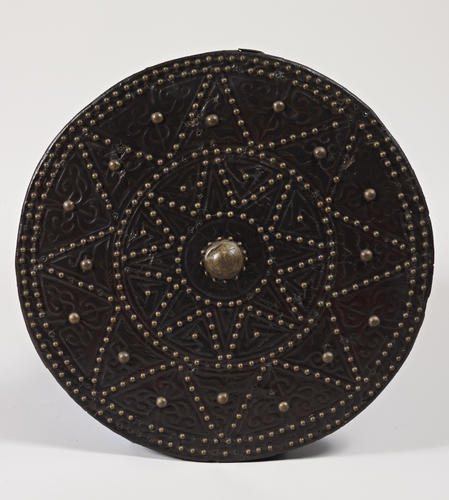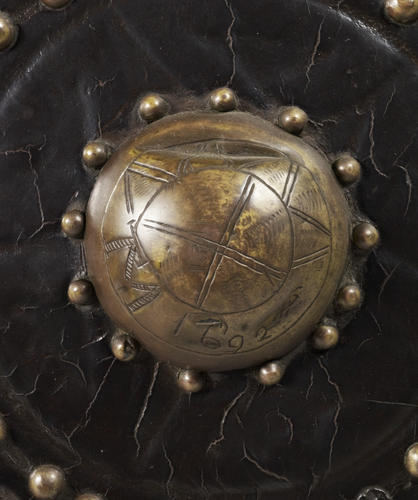-
1 of 253523 objects
Highland target (targaid) 1692
Pine, leather, brass | RCIN 67310
-
Highland target (targaid) of circular form and made of two thicknesses of pine boards set at right angles to one another and covered on the front face with brown leather, blind-tooled and secured by numerous low dome-headed, all-brass nails with shanks of rectangular section, some of them now missing.
The decoration is arranged in four concentric circles, each outlined with closely spaced nails. The narrow outermost circle, is tooled with a band of stylised roping. The second and third bands are filled with contiguous triangular panels; each triangle is outlined with nails. Those of the second circle have at their respective centres a dome-headed nail. In the second circle the surface of each triangle is embossed with a trefoil having pointed tips and recessed scrolling veins. In the third circle each of the larger triangles is tooled with a triquetral knot, and each of the smaller ones, with a central ornament shaped as a concave-sided lozenge.
The plain innermost circle contains a central brass boss, secured around its edge by 13 smaller brass nails. The centre of the boss is engraved with a saltire, and the lower part of its dome with a bold zigzag, the capital letters ‘TM’ in monogram and the date 1692. Some of the interspaces are filled in with wriggle-work. At some time the boss has received a heavy, diagonal cut.
The rear of the target is now covered with plain leather concealing the holes for the original grip and brase. A torn section at the edge of this backing reveals that the edge of the front leather is slashed diagonally to form tabs, the left corner of each overlapping the right corner of its neighbour where it is secured by a single headless iron nail, the end of which is clinched over. A hole has been roughly pierced near the edge of the target for suspension, and a second hole in the second circle of its decoration has been roughly plugged. Several cuts in the surface may be the result of bayonet thrusts.
Measurements: diameter of front board with the grain of the wood 52.7 cm; diameter across the grain: 53.4 cm.
Weight: 2.551kg.
Text adapted from Arms and Armour in the Collection of Her Majesty The Queen: European Armour, London, 2016Provenance
The Carlton House Catalogue records the presentation of the target by a ‘Mr Scott’ in November 1816. 'Mr Scott' may possibly be the future Sir Walter Scott; it is known he dined twice with the Prince Regent at Carlton House in the summer of 1815. Although there is no reference to such a gift in Scott’s correspondence, a target would have been a very suitable present for him to make to his host, perhaps in return for the jewelled gold box sent to him by the Prince in May 1815.
The plain leather on the back of the target is explained by an entry in Cuff’s bill for the period 16 April to 15 September 1819: ‘Covering a shield in Leather’ at 5s. 6d.
The target was ‘Delivered to Mr Wilkie to Introduce into the Painting of His Majesty’s Portrait’ on the 7 July 1829 and returned on 17 July 1830. It was again ‘sent to Mr Wilkie to Draw From’ on 26 November 1832 and was returned on 30 November. The paintings, by Sir David Wilkie (1785-1841), are respectively the full-length portrait of George IV in Highland dress, now at the Palace of Holyroodhouse (RCIN 401206), and a version painted for the Duke of Wellington, now at Apsley House.
Recorded as item no. 2691 in the Carlton House Catalogue for March 1815-May 1820, and subsequently as item no. 1134 in the North Corridor Inventory of Windsor Castle. -
Creator(s)
(maker)Acquirer(s)
-
Medium and techniques
Pine, leather, brass
Category
Object type(s)
Subject(s)
Other number(s)


